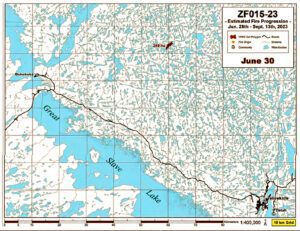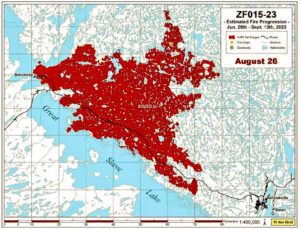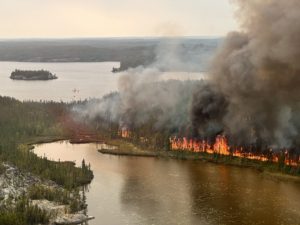Misinformation from the public, poor internal communications, contractors “exploiting” the emergency, casual firefighters showing up drunk or high, and a lot of on-the-job stress and subsequent mental health issues were some of the previously unknown aspects from last year’s wildfire season.
A 212-page review of NWT’s Environment and Climate Change Department (ECC) by auditors MNP released today also revealed “a significant underestimation regarding the situation and potential wildfire behaviour,” when Yellowknife was deemed not under threat to requiring a full evacuation of the capital within five days.
The timeline in the $300,000 Northwest Territories 2023 Wildfire Response Review also shows wildfire ZF015-23 – the Behchokǫ̀/Yellowknife blaze – started out by a lightning strike on June 28, but the 56-hectare fire was classified as needing “limited action.”

Fire ZF015-23 on June 30, shortly after it was caused by a lightning strike. (Image courtesy of the GNWT)
The initial assessment highlighted the remote location of the fire, noting the presence of old burns and surrounding water bodies that provided natural containment.
An initial attack crew was not immediately deployed as the fire was relatively large at detection, and the very dry conditions, and high to extreme wildfire danger would require resources being diverted from other priority fires, such as ZF009-23 burning near the community of Wekweètì, stated the report.
Over the subsequent weeks, wildfire ZF015-23 continued to grow, exhibiting “aggressive wildfire behaviour,” spreading southward and westward towards Great Slave Lake with homes/cabins to the south and the community of Behchokǫ̀ to the southwest.
Behchokǫ̀ was ordered to evacuate on July 24th.
“It is unclear, based on conflicting information when fire protection sprinklers were set up on select structures within and outside of Behchokǫ̀,” stated the report.

Fire ZF015-23 on August 6th, the day Yellowknife’s evacuation order issued. (Image courtesy of the GNWT)
“The available information suggests sprinklers were installed in and around July 24 to 26. By the end of the day on July 24, the wildfire had burned 15 structures along Highway 3.”
It also appears an indirect attack operation – lighting unburned trees and brush to try and box in the main blaze — at Stagg River and Highway 3 to the east of the community could have added to the threat and loss experienced in Behchokǫ̀.
The reported stated it’s unclear whether all factors were considered in the decision-making process and the ignition plan was not signed off by the regional fire manager.
“This is not meant to suggest that the individuals who implemented the ignition plan were not competent, but rather that their competency was not validated and subsequently certified,” stated the report.
The size and intensity of the wildfire and wind direction caused ZF015-23 to run westward towards Behchokǫ̀ while the indirect attack ignition moved westward towards Behchokǫ̀ ahead of the main wildfire.
The indirect attack operation was overrun by the main wildfire. Had it not been consumed by the main wildfire, the indirect attack ignition would

Fire ZF015-23 on August 26th, showing a stalled fire in the direction of Yellowknife. (Image courtesy of the GNWT)
have likely burned to the north of the community.
“It is clear that the main wildfire was on course to impact Behchokǫ̀. It remains uncertain whether the indirect attack ignition would have impacted Behchokǫ̀. Should it have done so, it would have reached the community approximately four hours before the main fire.
Records indicate the ZF015-23 encroached upon the community on July 26, with three structures lost to the wildfire.
Yellowknife, N’dilo, Dettah, and the Ingraham Trail were evacuated on August 16, but fire ZF015-23 had minimal growth in the days after residents flew or drove south. People were allowed to start returning on September 6th.
For the Northwest Territories 2023 Wildfire Response Review – Final Report firefighters, managers, team leads, officers, directors, RCMP officers, mayors, fire chiefs, senior administrative officers, ministers, operators and more.
In total, 104 ECC staff and select stakeholders were involved in sharing insights and feedback to develop this report.
Some more of the report’s findings:
- Many participants shared they had never experienced a fire season such as the 2023 wildfire season. As such, the need for more effective fire behaviour modeling tools was noted by multiple regional offices.
- It is unclear how well the escalating situation in the South Slave with fire SS052-23 was communicated to Hay River, Enterprise, Kakisa, and Kátł’odeeche First Nation. As late as August 12th, evacuees from Fort Smith were arriving in Hay River, and the annual Enterprise Gateway Jamboree was underway with 600 visitors in Enterprise. Regional EMOs and employees reported limited communication about the changing fire situation, which saw some structure loss on the First Nation and almost complete loss of Enterprise.
-

There are still some areas in Enterprise that haven’t been cleaned up after last year’s devastating wildfires. (James O’Connor/CKLB)
Participants shared equipment was not being properly logged and couldn’t be accounted for and occasionally went missing. There were reported instances of equipment being left in the field or stolen.
- Many participants shared that they believe they now have post-traumatic stress disorder (PTSD) because of the events from last season.
- Finding enough crews resulted in lax enforcement of disciplinary measures in response to tardiness, use of substances, unauthorized phone usage while on active duty, and instances of personnel abandoning their assigned posts for extended periods.
- The high demands on firefighters led to significant mental and physical health challenges, which prompted ECC to explore new approaches to mental health support, including culturally appropriate services.
- In response to the tragic loss of a wildland firefighter out of Fort Liard. ECC reached out to a traditional Dene healer to help those who were impacted by the individual’s death. This attempt by ECC to broaden its employee mental health support is a step in the right direction.
- Multiple participants stated that certain contractors were “exploiting the situation.”
- ECC utilized various platforms, including social media, to share updates and engage the public. However, posts by elected politicians’ personal social media accounts caused confusion.
- A large amount of misinformation was posted by civilians, causing confusion amongst the public and hindering the fire response.
- ECC and the GNWT reportedly are exploring prescribed burns as a community protection method, involving Indigenous knowledge and collaboration, though these initiatives are still in the planning stages pending funding.
In 2023, wildfires in NWT burned over 3.4 million hectares, marking a significant increase from previous recorded years. NWT also recorded the highest temperatures on record for a single day, summer, and fall, as well as the longest period without rainfall.
More than 4.1 million hectares of forest were affected by 303 wildfires during the 2023 wildfire season.
The GNWT stated many of the 25 recommendations for immediate action and 17 opportunities for improvement to be considered over the next one to three years have already been during the 2024 wildfire season. Others will be considered, pending budget flexibility.

Wildfire ZF015-23 on Aug. 17, 2023. (Photo courtesy of NWT Fire)






